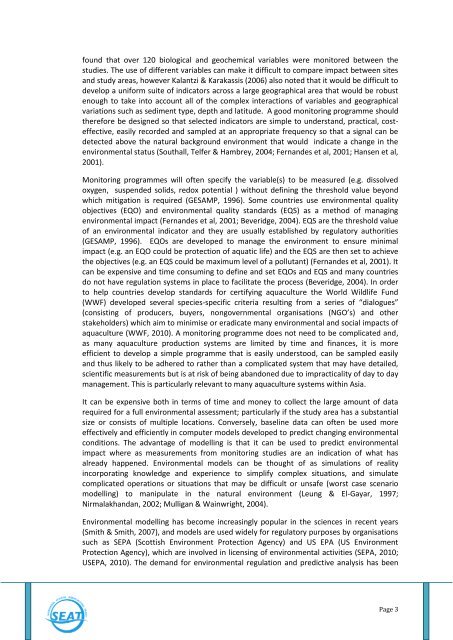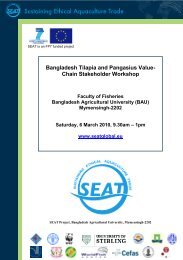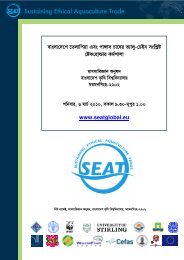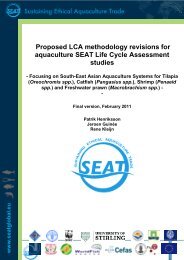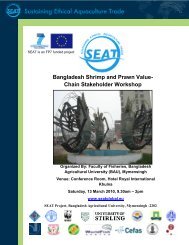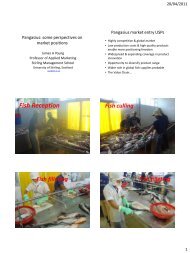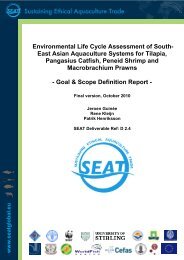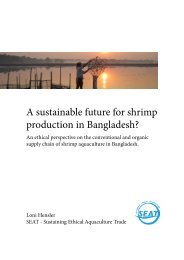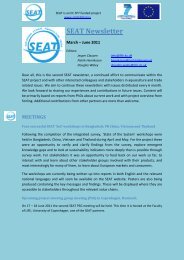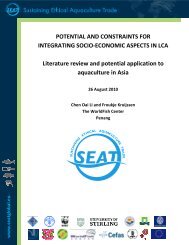D4.1 Review of Environmental Models - SEAT Global
D4.1 Review of Environmental Models - SEAT Global
D4.1 Review of Environmental Models - SEAT Global
Create successful ePaper yourself
Turn your PDF publications into a flip-book with our unique Google optimized e-Paper software.
found that over 120 biological and geochemical variables were monitored between the<br />
studies. The use <strong>of</strong> different variables can make it difficult to compare impact between sites<br />
and study areas, however Kalantzi & Karakassis (2006) also noted that it would be difficult to<br />
develop a uniform suite <strong>of</strong> indicators across a large geographical area that would be robust<br />
enough to take into account all <strong>of</strong> the complex interactions <strong>of</strong> variables and geographical<br />
variations such as sediment type, depth and latitude. A good monitoring programme should<br />
therefore be designed so that selected indicators are simple to understand, practical, costeffective,<br />
easily recorded and sampled at an appropriate frequency so that a signal can be<br />
detected above the natural background environment that would indicate a change in the<br />
environmental status (Southall, Telfer & Hambrey, 2004; Fernandes et al, 2001; Hansen et al,<br />
2001).<br />
Monitoring programmes will <strong>of</strong>ten specify the variable(s) to be measured (e.g. dissolved<br />
oxygen, suspended solids, redox potential ) without defining the threshold value beyond<br />
which mitigation is required (GESAMP, 1996). Some countries use environmental quality<br />
objectives (EQO) and environmental quality standards (EQS) as a method <strong>of</strong> managing<br />
environmental impact (Fernandes et al, 2001; Beveridge, 2004). EQS are the threshold value<br />
<strong>of</strong> an environmental indicator and they are usually established by regulatory authorities<br />
(GESAMP, 1996). EQOs are developed to manage the environment to ensure minimal<br />
impact (e.g. an EQO could be protection <strong>of</strong> aquatic life) and the EQS are then set to achieve<br />
the objectives (e.g. an EQS could be maximum level <strong>of</strong> a pollutant) (Fernandes et al, 2001). It<br />
can be expensive and time consuming to define and set EQOs and EQS and many countries<br />
do not have regulation systems in place to facilitate the process (Beveridge, 2004). In order<br />
to help countries develop standards for certifying aquaculture the World Wildlife Fund<br />
(WWF) developed several species-specific criteria resulting from a series <strong>of</strong> “dialogues”<br />
(consisting <strong>of</strong> producers, buyers, nongovernmental organisations (NGO’s) and other<br />
stakeholders) which aim to minimise or eradicate many environmental and social impacts <strong>of</strong><br />
aquaculture (WWF, 2010). A monitoring programme does not need to be complicated and,<br />
as many aquaculture production systems are limited by time and finances, it is more<br />
efficient to develop a simple programme that is easily understood, can be sampled easily<br />
and thus likely to be adhered to rather than a complicated system that may have detailed,<br />
scientific measurements but is at risk <strong>of</strong> being abandoned due to impracticality <strong>of</strong> day to day<br />
management. This is particularly relevant to many aquaculture systems within Asia.<br />
It can be expensive both in terms <strong>of</strong> time and money to collect the large amount <strong>of</strong> data<br />
required for a full environmental assessment; particularly if the study area has a substantial<br />
size or consists <strong>of</strong> multiple locations. Conversely, baseline data can <strong>of</strong>ten be used more<br />
effectively and efficiently in computer models developed to predict changing environmental<br />
conditions. The advantage <strong>of</strong> modelling is that it can be used to predict environmental<br />
impact where as measurements from monitoring studies are an indication <strong>of</strong> what has<br />
already happened. <strong>Environmental</strong> models can be thought <strong>of</strong> as simulations <strong>of</strong> reality<br />
incorporating knowledge and experience to simplify complex situations, and simulate<br />
complicated operations or situations that may be difficult or unsafe (worst case scenario<br />
modelling) to manipulate in the natural environment (Leung & El-Gayar, 1997;<br />
Nirmalakhandan, 2002; Mulligan & Wainwright, 2004).<br />
<strong>Environmental</strong> modelling has become increasingly popular in the sciences in recent years<br />
(Smith & Smith, 2007), and models are used widely for regulatory purposes by organisations<br />
such as SEPA (Scottish Environment Protection Agency) and US EPA (US Environment<br />
Protection Agency), which are involved in licensing <strong>of</strong> environmental activities (SEPA, 2010;<br />
USEPA, 2010). The demand for environmental regulation and predictive analysis has been<br />
Page 3


